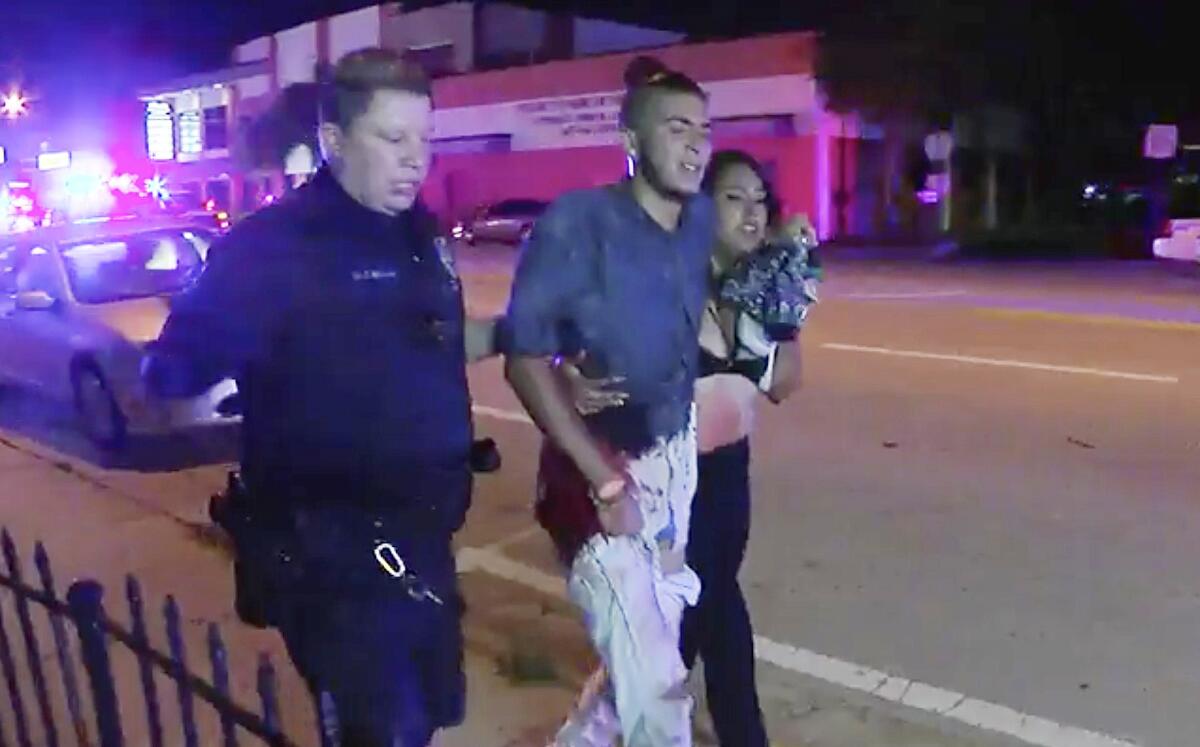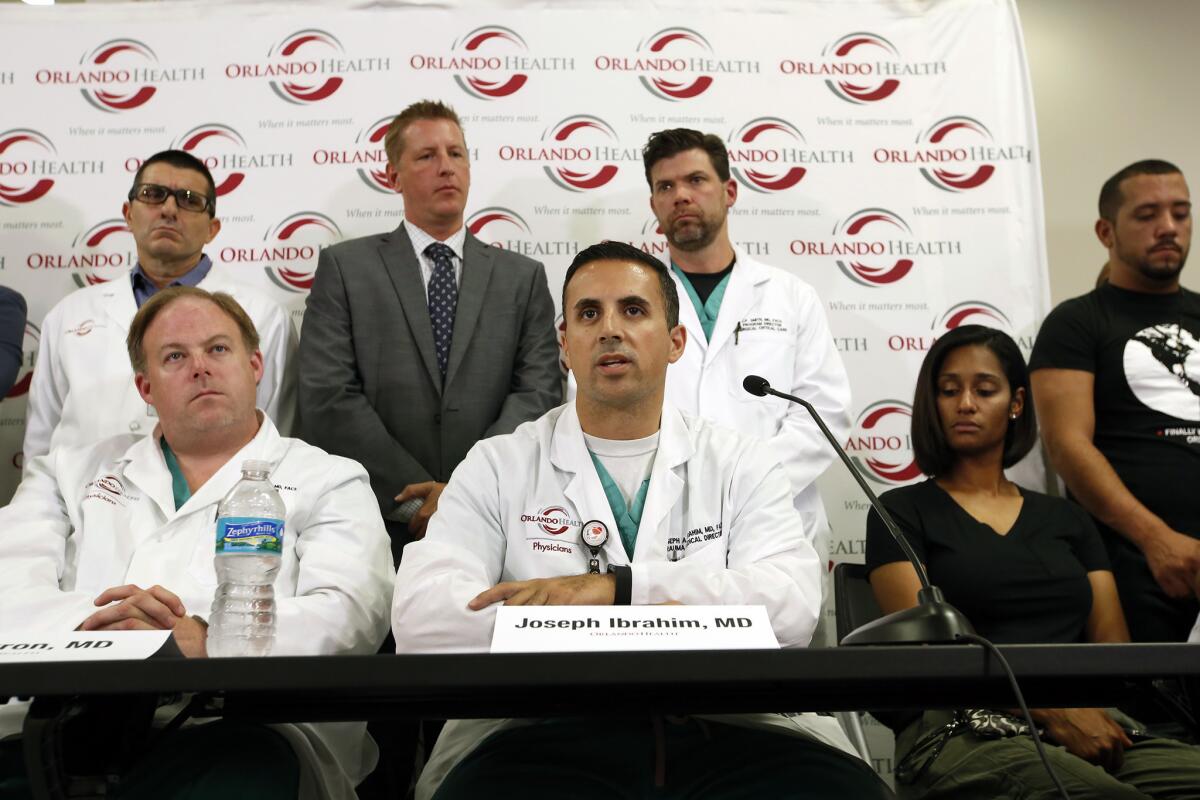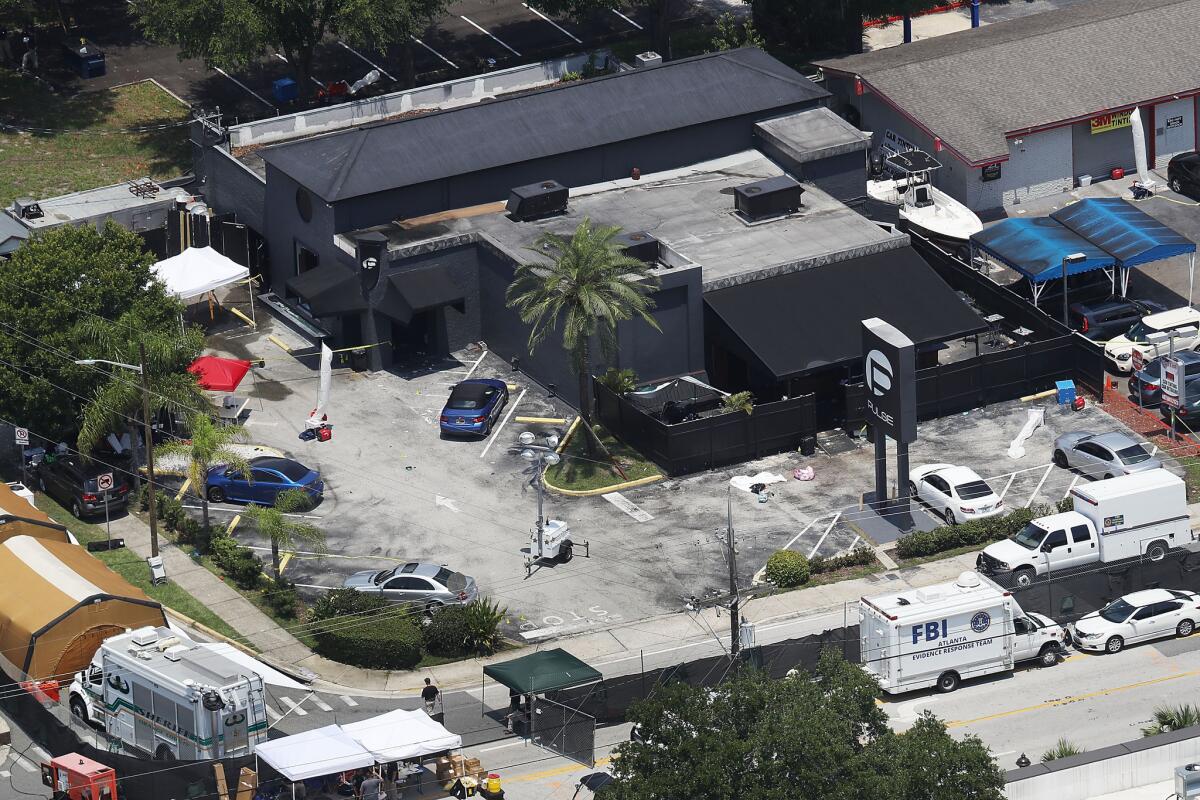Paramedics barred from saving Orlando shooting victims because club was deemed too dangerous

- Share via
Paramedics responding to the Orlando, Fla., nightclub shooting never entered the building throughout the three-hour standoff because it was considered too dangerous, officials said Wednesday.
The attack at the Pulse nightclub left 49 dead and more than 50 wounded. It’s unclear how many could have been saved had paramedics been able to enter the gay club between the time the shooting was reported at about 2 a.m. and when it ended shortly after 5 a.m..
The Orlando Fire Department has a station a block away from the club and paramedics were on the scene within minutes of when the shooting started, according to Deputy Fire Chief Richard Wales.
The department sent more than 80 personnel and 34 vehicles, but they were forced to remain outside, treating the wounded who emerged or were rescued by police, he said.
“There were no EMS teams going in because at that time it was still a ‘hot zone.’ It was not a ‘warm zone,’” Wales said.
Typically at active shootings, rescue workers are told to wait in safe, or “cold,” zones until law enforcement can clear “hot zones” where gunmen are still active. Whether a zone is hot or warm can change depending on the shooter’s movements, weaponry and the configuration of the building, experts say.
I completely understand why they didn’t enter, but I also think that rationale ... needs to be updated to include the actual risks to EMS providers.
— Geoff Shapiro, director of emergency medical services training at George Washington University
But paramedics have been responding more aggressively to active shootings in recent years as federal guidelines and training have evolved.
The Federal Emergency Management Agency has called for fire department medics, working with police, to enter warm zones — areas near active shooters where a threat still might exist — before attackers are fully contained. Some paramedics now train to accompany police into hot zones like battlefield medics.
“The cultural barriers that existed in fire and EMS [agencies] to entering areas of danger that involved ballistics or explosive threats have changed,” said E. Reed Smith, medical director of the Arlington County Fire Department in Virginia and an advisor on the federal government’s new guidelines. “We have to get in there to stop the dying.”
He said the aggressive approach to life-saving gained traction after the Columbine, Colo., school shooting in 1999, in which medical crews and police waited for a SWAT team outside for nearly an hour as a teacher died.
“As long as we’re standing outside, we have not stopped the dying,” Reed said.

U.S. Fire Administrator Ernest Mitchell Jr., former fire chief in Pasadena and Monrovia, said law enforcement tried to respond more quickly after Columbine, and fire agencies developed more rapid responses after the mass shooting at a movie theater in Aurora, Colo., in 2012.
New FEMA guidelines issued for paramedics in 2013 included identifying warm zones where they could treat patients without a direct threat.
Now they’re working to update those fire agency guidelines by summer’s end to include policies, procedures and data on how to more rapidly treat victims of active shootings, he said.
While some agencies are entering active shooting hot zones, he said, that “takes ballistics protection; it takes training and coordination with the law enforcement team they’re going in with.”
He said Orlando was especially difficult, given the size of the building and the hostage negotiations that took place with the barricaded shooter.
The new, more aggressive responses include entering the building with police to reach victims as a “rescue task force,” or entering the building after police create a “warm corridor” to extricate the wounded or after they create a “protected island” within the building where they can treat victims. Paramedics typically focus on stopping bleeding, clearing airways and treating chest wounds that often lead to death in mass shootings.
“You want a paramedic beside you as soon as possible,” Reed said.
After the mass shooting in Aurora, police rushed the wounded to hospitals in their cruisers, “not unlike what they did at the Pulse nightclub,” Reed said. He added that “although they saved a lot of lives, they did not stop the dying” in Aurora.
Paramedics were more aggressive in responding to the Boston Marathon bombing two years ago, rushing to the scene and treating the wounded despite repeated blasts.
Before the mass shooting in San Bernardino last year, SWAT team members happened to be training nearby. They responded to the shooting with their own medic. A SWAT medic also happened to be at Virginia Tech to aid victims after the mass shooting there in 2007.
Reed said the Orlando paramedics’ response was “reasonable,” but he questioned what factored into the decision to hold back – and what impact it may have had on the death toll.
“The question we’re all asking is did somebody in the building die because paramedics didn’t get to them?” he said.
Geoff Shapiro, director of EMS and operational medicine training at George Washington University, also questioned how much of a hot zone the club was once the shooter retreated to rear bathrooms during the standoff.
“I completely understand why they didn’t enter, but I also think that rationale, that way of thinking, needs to be updated to include the actual risks to EMS providers,” Shapiro said. “Fire personnel work in dangerous scenarios every day, and arguably a firefighter entering a burning building is as dangerous as entering a club where there’s an active shooter.”
By the time the standoff ended and the building was cleared, all of the remaining victims were dead, according to Lori Moore, head of fire and EMS operations for the International Assn. of Firefighters union in Washington.
Moore, who has been briefed by Orlando EMS officials, said the structure of Pulse nightclub made it difficult for police to allow paramedics inside.
“When law enforcement made entry they could not clear the entire facility. That’s why EMS did not make entry,” Moore said.

She said a “rescue task force” might have entered with the second wave of police who stormed the building, but because it had not been cleared, “that could not happen.”
“Everyone operated exactly as they should have,” she said. “They were told they would not be making entry and the victims would be moved out to them.”
Capt. Mark Canty, Orlando Police SWAT commander, said officers rescued people from inside the club during the standoff, but did not say whether they administered first aid. He and a police spokeswoman did not return calls Wednesday.
However, Dr. Joseph Ibrahim, a surgeon who was involved in the emergency response, said at least some of the police who dropped off victims of the shooting at nearby Orlando Regional Medical Center had rendered first aid.
“The main things they would do would be to put tourniquets on, because that’s part of their uniform now. They would put tourniquets on the extremities to stop the bleeding. That was basically all they could do. They were that close,” he said.
Paramedics took 26 victims to hospitals, where nine died soon after arriving. It’s unclear whether any of the 40 victims who died inside the club could have been saved, the deputy fire chief said.
“There will be a lot of people who second-guess what happens,” Wales said.
“We have active-shooter training we have done with [the] Orlando Police Department and we have been doing this for some time. The capability is there; our level of training is increasing,” he said. “They knew where to go and exactly what the next steps should be.”
He said Orlando fire staff had trained in international trauma life support, “the battlefield model,” and used those tools as they treated victims outside the nightclub.
“Many lives were saved,” said Wales, who has been with the department 25 years.
While the department has responded to other active shootings, those ended before warm zones developed, he said.
“That’s what sets this one apart: that this was over a period of time,” Wales said. “This is one of the most heartbreaking scenarios anyone will ever be in over a lifetime.… We learn as a nation this is how you handle this kind of a situation. Undoubtedly, there will be lessons learned.”
ALSO
Ex-House Speaker Dennis Hastert starts prison term
Driver was on drugs when he killed 5 Michigan bicyclists, prosecutor says
Michigan attorney general sues 2 companies over lead-tainted Flint water
More to Read
Sign up for Essential California
The most important California stories and recommendations in your inbox every morning.
You may occasionally receive promotional content from the Los Angeles Times.











